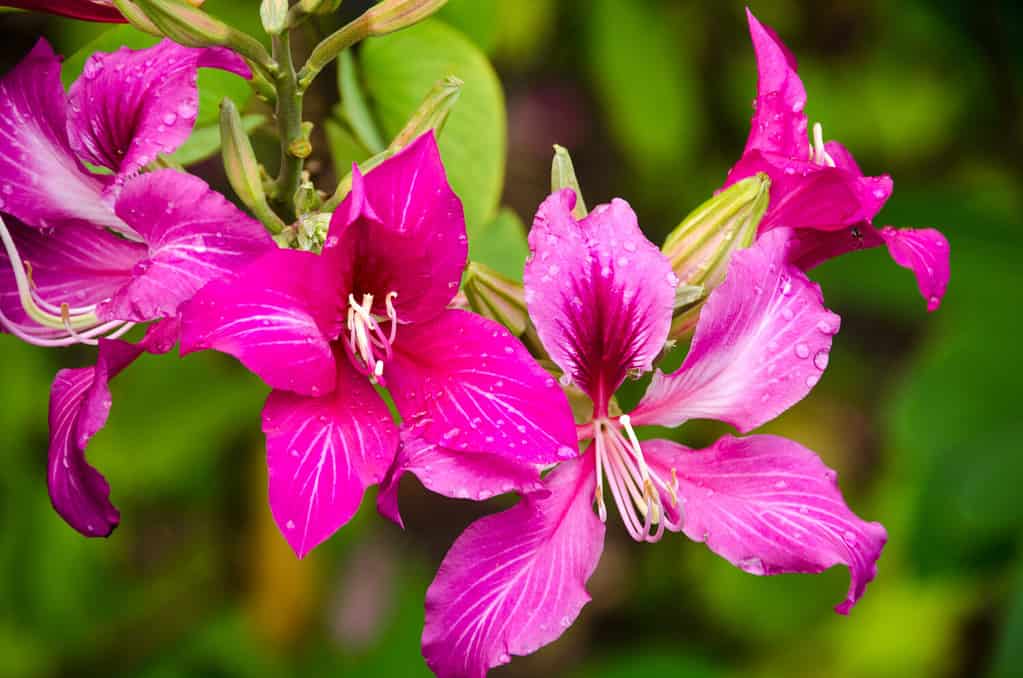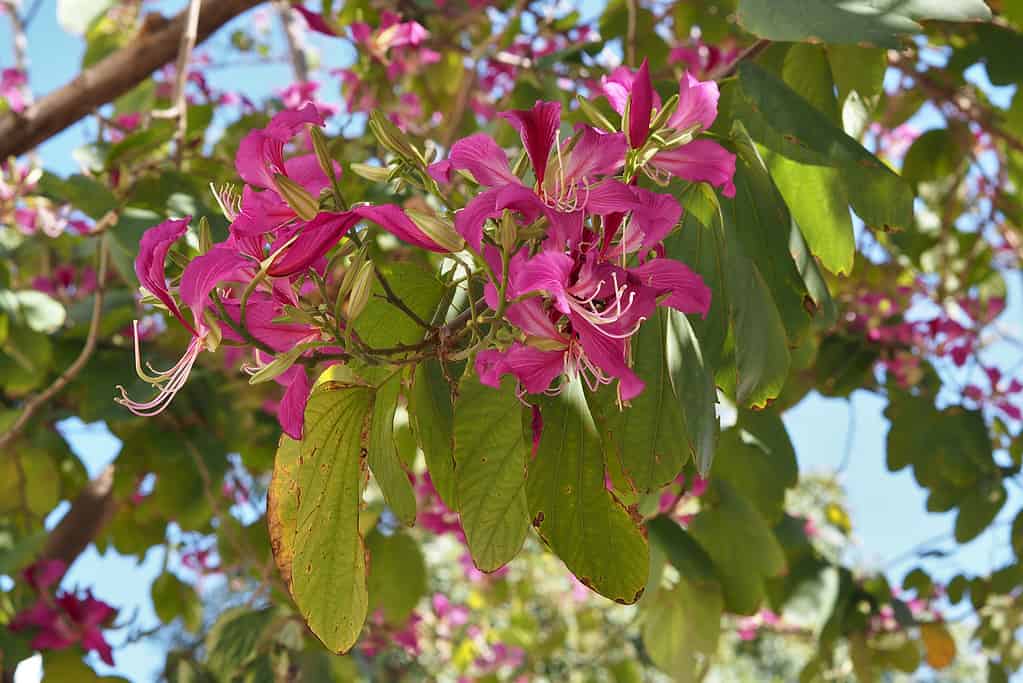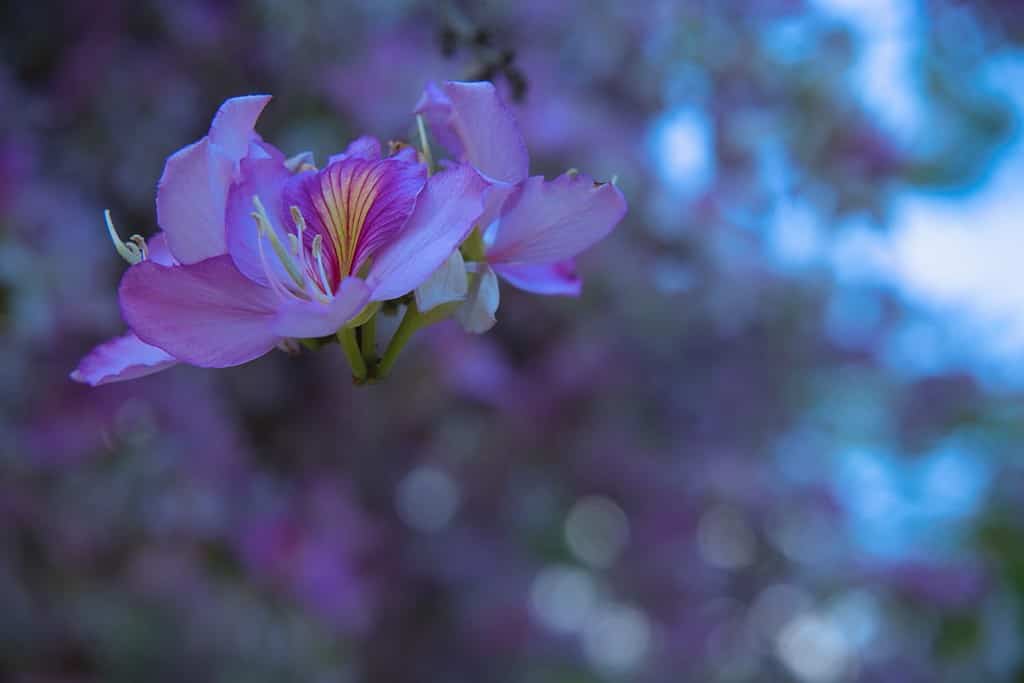Orchids are beautiful flowers that are somewhat difficult to grow. But did you know that there are trees with flowers similar to orchids that are much easier to take care of? They are known as orchid trees. Growing orchid trees in Florida is pretty easy, once you know what you’re doing.
Sometimes, when people talk about orchid trees, they mean a tree that has orchids growing on the tree. However, there are also these trees above, which are classified as orchid trees. These actual trees, and not trees with flowers growing in them, are the ones this article is covering.
What Are Orchid Trees?

While orchid trees aren’t part of the orchid family, they have eerily similar flowers.
©konjaunt/Shutterstock.com
Orchid trees (Bauhinia spp.) aren’t actually orchids, nor are the flowers they produce. However, the flowers do look similar to some species of orchids. They even attract similar species of pollinators, such as hummingbirds.
These trees like warmth. They’re most common in Hawaii, Southern California, Texas, Florida, and Louisiana. They need full sun, a little more acidic soil, and constantly warm temperatures.
Some species of orchid tree include:
- Bauhinia foficata
- Bauhinia monandra
- Bauhinia x blakeana
- Bauhinia macranthera
- Bauhinia variegata
- Bauhinia lunarioides
- Bauhinia galpinii
- Bauhinia tomentosa
Do Orchid Trees Grow Well in Florida?

From a distance, it’s easy enough to confuse these flowers for orchids.
©CHI WAI CHEVY WAN/iStock via Getty Images
Orchid trees grow exceptionally well in Florida. They enjoy slightly acidic soils with a very sunny and constantly warm climate. That describes a large amount of Florida, especially the southernmost part. They do so well in the state that they don’t need much care. However, there are some tips and tricks that will help you make sure that your orchid trees grow without a problem.
How to Care for Orchid Trees
Orchid trees do best in US Hardiness Zones 9-11. This means that orchid trees do best in the southernmost parts of Florida. However, they may survive in all of Florida with the right care. The most important part is making sure that they stay warm and get enough sun.
Of course, every species of orchid tree is slightly different. Some do better in certain zones than others and have slightly different requirements. While these are general care guidelines for all orchid trees, it’s important to consult guidelines for the specific species you’re looking at as well.
Light
When it comes to the sun, orchid trees need a lot of it. It’s best to make sure they are getting full sun. These trees will do alright in partial sun, but if you want to produce the most flowers and the most vibrant colors, they need plenty of light.
Water
The heat and humidity of Southern Florida is best. For the most part, the orchid trees don’t have to be watered much. In the winter, they can go with very little watering. In the summer, a moderate, regular schedule is fine when it’s dry. During rainier years, you don’t have to water it much at all.
Soil
Soil drainage is also important. They prefer neutral to slightly acidic soil. Too alkaline, and the leaves struggle to maintain their green color and start to turn yellow. The soil also needs to drain well, such as with loamy soil. They like a lot of water but don’t want to sit in it for long periods.
Invasive Species

If you live in Southern Florida, it’s best to avoid this purple variety of orchid trees above, as they are an invasive species.
©Ruth Laguna/Shutterstock.com
While most species of orchid trees are perfectly fine to keep in Florida, there’s one you should avoid planting, depending on where you like. The B. variegata, also known as B. purpurea, is considered invasive in Florida. Its common names include “purple orchid tree,” “mountain ebony,” and “poor man’s orchid.”
According to the Florida Exotic Pest Plant Council, this species of orchid tree is listed as a Category 1 invasive species. This means it either displaces native trees, changes up the native communities in the area, or hybridizes with native plants, which therefore makes the original species endangered.
While most other species of orchid trees are fine, this one should be avoided by those living in Florida to prevent the further spreading of this invasive species. They propagate easily, which means it takes very little time for these tree orchids to take over.
This tree is only a problem in South Florida, where it grows the best. In Central Florida, it needs careful monitoring to stop its spread. In North Florida, however, it’s not considered a problem at all and can be planted in any area without any issues.
The photo featured at the top of this post is © Bowonpat Sakaew/iStock via Getty Images
Thank you for reading! Have some feedback for us? Contact the AZ Animals editorial team.







